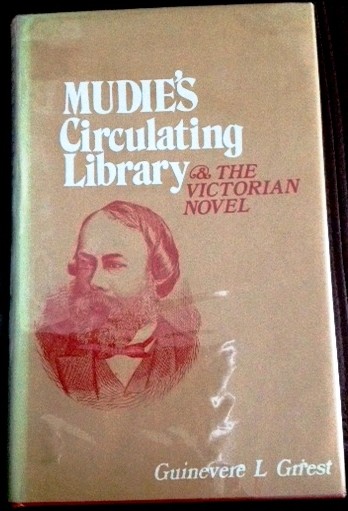Inspiring Older Readers
 posted on 13 Mar 2022
posted on 13 Mar 2022
Mudie’s Circulating Library & the Victorian Novel by Guinevere L. Griest
In recent years we have become accustomed to some unwelcome discussions about the funding and future of our public libraries. The service has, I’m glad to say, plenty of people prepared to mobilise in their support but it’s undoubtedly true that the network is in its most precarious state – certainly at its most vulnerable at any point in my lifetime.
I have never personally been a big user of the public library service but I grew up thinking of libraries as a natural part of the wider welfare state and I’m aware of the debt so many owe to them. For many working class autodidacts public libraries have been a critically valuable resource and the stories of long hours spent in the stacks are legion.
The emergence of a free public library service has a long gestation period and several key dates when the idea moved into a new phase of development. But our current concept of the public library and its mission was perhaps set in the 1960s – something that David McMenemy describes in this way in his paper for the University of Strathclyde called “Public Libraries in the UK – history and values”:
“The most significant development in the later part of the 20th century was the adoption of a new Act of Parliament for libraries, the 1964 Public Libraries and Museums Act, which came into force in April 1965. The most important component of this Act was that it made it a statutory obligation for a local authority to provide a ‘comprehensive and efficient’ public library service for its community.”
So what happened before there was a free, comprehensive library service available to everyone somewhere close to where they lived? Well, Guinevere Griest’s book gives us an insight into one of the commercial services – circulating subscription libraries – that provided access to expensive books for a middle class audience who couldn’t afford to purchase the latest releases. Mudie’s Circulating Library wasn’t the only subscription library but it was certainly, for a while, the king of them all and, Griest argues, not only made books available but actually shaped how books were written and published.
Mudie was the son of a bookseller/newsagent and in 1848 he spotted the chance to provide new books on loan for a subscription fee that was a small portion of the published cover cost. Once the book had lost its lending power he would then sell it as a second hand book and recoup more of the initial investment. Although he initially wanted to make a whole range of books on different topics available, it was fiction that came to dominate – partly because of the way novels were written and released in several volumes. Mudie’s business plan was best suited by a three volume book – known as a three-decker – that maximised the income he could generate through this subscription base. Mudie became so successful and purchased new books in extraordinary numbers that he required premises with huge catacomb archives and a growing number of staff to keep the administration working.
Soon novelists were writing books in three parts simply with an eye on being picked up by Mudie’s and the convention became both hard to break and a burden to authors. It wasn’t too long before people started to question whether the need to write in three volumes was actually producing second and third rate books artificially puffed up simply to meet the demand for multi-volume publication.
Interestingly enough, by the turn of the century the pressure for books that were written in a more concise way and often in just one volume was growing to such an extent that Mudie himself endorsed the trend.
It turned out to be the beginning of the end for this model of the circulating library and the behemoth that was Mudie’s began slipping into decline and was as good as done for by the time the Edwardian age came crashing to an end in 1914.
Those of you interested in the details and financial figures that Mudie worked with will find that Griest has dug deeply into the business model and drawn out the links between the subscription library and the development of the novel. You’ll also find out how the Mudie model worked in relation to a service provided by W.H. Smith and, subsequently, Boots – two more nimble library services that came to replace what Mudie had created.
This book was published in 1970 and is, I think, currently out of print. Second hand copies are available however and you can pick one up for around £10.
Terry Potter
March 2022